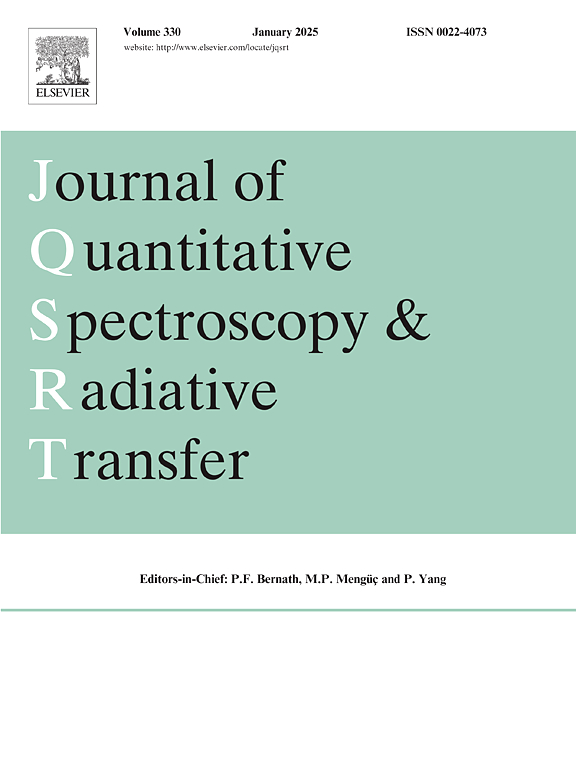Accurate N2O IR line lists with consistent empirical line positions: ABG-IMRHT and Ames-2000K
IF 2.3
3区 物理与天体物理
Q2 OPTICS
Journal of Quantitative Spectroscopy & Radiative Transfer
Pub Date : 2025-04-29
DOI:10.1016/j.jqsrt.2025.109502
引用次数: 0
Abstract
We report the second generation of Ames N2O IR line lists, ABG-IMRHT for room-temperature and Ames-2000K for high temperature applications. The ABG-IMRHT line list utilized a new potential energy surface (PES), B1b, refined from a refit of Schröder’s Comp I PES [10.1515/zpch-2015–0622] with σrms = 0.006 cm-1 for all reliable 14N216O levels in HITRAN2020 [10.1016/j.jqsrt.2021.107949], and a new dipole moment surface (DMS) G10K carrying fitting σrms = 6.1 × 10–7 au up to 10,000 cm-1. Compared to the previous Ames-296K line list, the PES and DMS upgrades have significantly reduced the line position deviations (δ) and relative intensity deviations (δ %), and maintained consistent accuracy across isotopologues. The line positions of the new ABG (Ames B1b + G10K) line lists including 12 stable N2O isotopolouges are enhanced by ∼100,000 global EH model based 14N216O levels from NOSL-296, and empirical levels determined from IAO, MARVEL, RITZ, HITRAN, and JPL(Toth) datasets, hence denoted ABG-IMRHT. Simple 0th-2nd order corrections are determined for ENOSL of about 20 vibrational states above 10,000 cm-1, based on ENOSL, ERITZ, and EMARVEL comparison. Uncertainty estimates are given for upper and lower state energies (E' and E"), line positions, and IR intensities. The Ames-2000K line list contains 3.4 billion IR transitions covering the 0–15,000 cm-1 range with Jmax=210 and E'/E"=0.125 Hartree (above the PES minimum) for 14N216O. It combines strengths of three components: “Ames-1″ computed using Ames-1 PES and a weighted DMS “G2d” for 12 isotopologues, “B1b” for 14N216O computed using B1b PES and G10K DMS with E' < 16,000 cm-1; and ABG-IMRHT line list. Comparison with HITEMP [10.1016/j.jqsrt.2019.04.040] and UCL TYM (ExoMol) [10.1093/mnras/stae2201] line lists are presented and discussed at T > 1000 K. This study represents a higher level of experiment-model-theory synergy, and a “block” approach for hot IR line list construction. The line lists and related datafiles are available online [10.5281/zenodo.14174306].

精确的N2O IR线表,经验线位置一致:ABG-IMRHT和Ames-2000K
我们报告了第二代Ames N2O IR线清单,ABG-IMRHT用于室温,Ames- 2000k用于高温应用。ABG-IMRHT线表采用了一种新的势能面(PES) B1b,该势能面是由Schröder的Comp I PES [10.1515/ zpch-2015-0622]改进而来,其σrms = 0.006 cm-1,适用于HITRAN2020 [10.1016/j.j jqsrt.2021.107949]中所有可靠的14N216O能级,以及一种新的偶极矩面(DMS) G10K,其拟合σrms = 6.1 × 10-7 au,最高可达10,000 cm-1。与之前的Ames-296K谱线列表相比,PES和DMS的升级显著降低了谱线位置偏差(δ)和相对强度偏差(δ %),并保持了各同位素组的一致精度。包含12种稳定N2O同位素的新ABG (Ames B1b + G10K)线列表的线位置由nols -296中基于~ 100,000个全球EH模型的14N216O水平以及IAO、MARVEL、RITZ、HITRAN和JPL(Toth)数据集确定的经验水平增强,因此称为ABG- imrht。基于ENOSL、ERITZ和EMARVEL的比较,确定了10000 cm-1以上约20种振动态的ENOSL的简单0 -2阶修正。给出了上下态能量(E′和E”)、线位置和红外强度的不确定性估计。Ames-2000K线列表包含34亿个红外转换,覆盖0-15,000 cm-1范围,Jmax=210和E'/E ' =0.125哈特里(高于PES最小值)。它结合了三个组件的优势:“Ames-1″”使用Ames-1 PES和加权DMS“G2d”计算12个同位素,“B1b”使用B1b PES计算14N216O,“G10K DMS”使用E' <;16000 cm - 1;和ABG-IMRHT线清单。本文给出了与HITEMP [10.1016/j.j jqsrt.2019.04.040]和UCL TYM (ExoMol) [10.1093/mnras/stae2201]线表的比较。1000 K。本研究代表了更高水平的实验-模型理论协同作用,并为热点IR线列表构建提供了“块”方法。线路列表和相关数据可在网上获得[10.5281/zenodo.14174306]。
本文章由计算机程序翻译,如有差异,请以英文原文为准。
求助全文
约1分钟内获得全文
求助全文
来源期刊
CiteScore
5.30
自引率
21.70%
发文量
273
审稿时长
58 days
期刊介绍:
Papers with the following subject areas are suitable for publication in the Journal of Quantitative Spectroscopy and Radiative Transfer:
- Theoretical and experimental aspects of the spectra of atoms, molecules, ions, and plasmas.
- Spectral lineshape studies including models and computational algorithms.
- Atmospheric spectroscopy.
- Theoretical and experimental aspects of light scattering.
- Application of light scattering in particle characterization and remote sensing.
- Application of light scattering in biological sciences and medicine.
- Radiative transfer in absorbing, emitting, and scattering media.
- Radiative transfer in stochastic media.

 求助内容:
求助内容: 应助结果提醒方式:
应助结果提醒方式:


